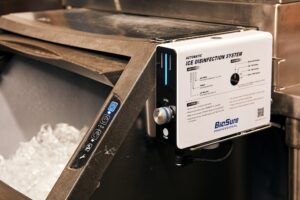Almost everyone who’s worked in the food and beverage industry knows that cleaning and disinfection of commercial kitchens and water lines are critical for keeping customers safe from bacterial infections. Chlorine has been traditionally used as a common method to disinfect surfaces and clean beverage water lines. But there’s an up-and-coming challenger in the arena of disinfection: Ozone water, otherwise known as ozone.
How it Works
Closely related to the oxygen molecule, ozone is naturally occurring, but its molecular composition makes it more reactive. It’s because of that molecular reactivity that ozone makes such a great disinfectant. (For more details on that process, read our previous blog post here.
Ozone is incredibly reactive with impure materials that end up in the water. This means that impurities, like iron, manganese, and biological pathogens instantly react with one of the atoms in the ozone compound. For biological matter, this means instant neutralization. Once the impurities are separated from the water molecules (H2O), they can be easily removed with a conventional filter. What’s left of the ozone molecule then turns back into oxygen, safe and stable once again.
Chlorine vs Ozone in Water Purification
Chlorine has been the traditional chemical process for water purification for decades. So let’s consider some of the reasons and compare the effectiveness of ozone as a better alternative.
Chlorine has traditionally been the most widely used product for water treatment in the world. Using it requires a simple process that the average person can easily handle by adding the right amount of chlorine to the water in liquid or tablet form. Chlorine is effective because, in water, the chemical is capable of bypassing the cellar structure of almost any bacteria and neutralizing it (with very few exceptions, such as cryptosporidium). However, the chlorination process may take long periods of time depending on the volume of water being treated.
In contrast, ozonation is equally effective at neutralizing bacteria or viruses, but it gets the job done within seconds. Ozone dissolves into the water making a highly concentrated ozonated water solution. 1ppm of ozonated water is equivalent to a 50ppm chlorine solution, resulting in excellent oxidation performance. Some reports suggest that ozonation is 3,000 times faster than chlorination in disinfecting water. Ozonation can also eliminate that pesky cryptosporidium pathogen mentioned above. If water can be so thoroughly disinfected by ozone in such a short amount of time, then why isn’t everyone using ozone?
Ozone has been misunderstood for decades due to a general lack of education and fierce lobbying of the chemical industry. Additionally, while chlorine is transferred in vats, ozone has been traditionally more difficult to store, much less transport any large amount very far. This means that for ozone to be applied at a water treatment facility, it needs to be generated on the spot. This can be done by exposing oxygen to electrical charges, known as electrolytic ozone generation. Compared to dropping chlorine tablets into a pool of water, the ozonation process has been known to be more involved. That is changing with the emergence of ozone generators.
The dangers of chlorine
Chlorine releases chemical residue that can be dangerous to us if ingested. They also leave a chemical taste in the water that is treated. Some studies suggest that chlorine in drinking water can increase the risk of cancer. Regular chlorination will also cause these residues to affect the equipment and the nearby environment.
Ozonation, however, when safely done, results in clean water with no chemical residues. In fact, ozone removes the residual byproducts left over from the chlorination process. Studies have also shown that chlorination is not as effective in bodies of water with a high alkaline pH. Meanwhile, ozonation is equally effective across the pH spectrum without altering the water’s pH level.
Ozone generators: a threat to chlorine
Until recently, the ozonation process for water treatment has not been as widely used as chlorination, even though it has been recognized by experts for its effectiveness. In the past, using ozone required a skilled technician to manage the creation of the ozone. Over the last several years, however, the technology required for ozonation has become more compact and safer to use for the average consumer. Ozonation doesn’t create dangerous byproducts within the water itself. After ozonation and a simple filtration process, the water will be free of impurities. Chlorine however will leave trace residues in the water that it treats.
Ozonated water generators have become a threat to chlorine solutions in their ability to eliminate problems related to chlorine use. These include chemical storage and handling issues, the problems and cost associated with chemical transportation, the significant chemical carbon footprint, and the role of human error when it comes to mixing chemical solutions. As a result, ozone is quickly becoming a better option for water treatment.
Ozone for health and a sustainable Earth
Comparisons of chlorine and ozone for water purification note that, while ozone’s oxidation and disinfectant ability is formidable, buying and installing the necessary equipment is not as cost-effective as chlorine. However, with technological developments and BES electrolytic ozone generators, the process of ozonation for water purification is becoming more convenient and much more affordable, with obvious cost savings over the mid to long term.
Ozone – the future of disinfection is now
Ozone’s numerous benefits for humans, for the earth, and for cutting costs make it the obvious solution for businesses looking for a modern water disinfection solution. In the post COVID-19 era, we no longer can take chances using dated methods for disinfecting water that ends up in our food, hospitals, and many other places where water quality is of the utmost importance.
Given the accessibility and cost-effectiveness of ozone generating technologies, the benefits of ozonation outweigh those of chlorination. Modern businesses should consider a move towards ozonation in a push for sustainability. And considering chlorine residual by-products and health and environmental concerns, ozone is a safer and more efficient option for water treatment and purification. The debate is no more.
Copyright besgroups.com All Rights Reserved
Related Articles
What is Ozone Water?
How Ozonated Water Works?
Ozone Spray vs 75% Alcohol for Sanitizing
Is Ozone Harmful to Humans?
What is the Advantage of Electrolytic Ozone?



